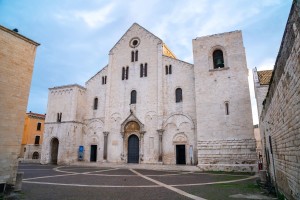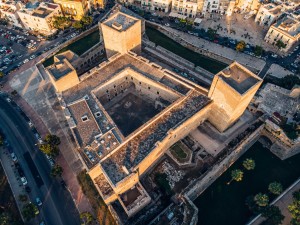It’s always Christmas in one of the southernmost Italian cities. Well, alright, that’s not entirely true, but the remains of one of the main protagonists for the run-up to the festive season rest in Bari. Saint Nicholas is both venerated and celebrated in the Apulian coastal city, and that’s just one of many aspects that make Bari a genuine city of arts. Situated near the heel of Italy, it opens up vast museums, spectacular churches, endless beaches and monumental military facilities to curious eyes like yours. Strap in, we’re heading for the capital of Apulia!
A city all about (maritime) trade
Bari’s history begins at a time before saints even existed. Earliest finds suggest first settlements during the Bronze Age. Trade relations with Greece were established soon, some Greeks even settled here later on, at least until the Romans took over the city and expanded it into a key trade hub with a port. The foundation for today’s archdiocese of Bari-Bitonto was laid as early as the 4th century AD. Like many other cities, Bari was a hotly contested commodity among roaming and invading nations after the fall of the Western Roman Empire becoming, among other things, the centre of the Emirate of Bari for about 20 years.
Bari itself blossomed during the 13th century. Frederick II saw to the extensive modernisation and expansion of the large castle. At the same time, wealth and trade increased throughout the city. The massive port construction/expansion was quickly abandoned, yet Bari continued to enjoy preferential treatment by bankers and merchants who took up residence here and/or had their major trade routes run through the Apulian port over the following centuries. Joachim Murat, as King Joachim of Sicily, had the new town redeveloped and expanded, modelling it after an octagonal grid. The quarters still carry his name.
Basilica and Festival of Saint Nicholas

©Bigstock.com/k.samurkas
Unlike other large maritime cities, such as Genoa, Venice and Amalfi, it took quite a long time for Bari to “adopt” their own saint. Southern Italian seafarers cracked open the sarcophagus of Saint Nicholas in Myra, today’s Demre in Turkey, in 1087 and stole his bones. Basilica San Nicola was built solely for these relics. Even though the crypt of the now Dominican church was consecrated as early as 1089, the actual final consecration only took place in 1197. The construction period of the monumental pilgrimage church might have stretched across a whopping 110 years, but the result speaks for itself. Being the epitome of Barese Romanesque architecture, the three-nave basilica became an ideal for many other churches throughout the region. Norman and Lombard influences adorn the entire building, yet the towers either disappeared completely or remained incomplete. Baroque alterations were extinguished completely save for the carved and gilded wooden ceiling, although the radiant depictions form a breathtakingly stark contrast to architectural sculptures which were revolutionary for their time.
According to legend, myrrh emanates from the bones of Saint Nicholas. A small bottle is lowered to his tomb on December 6th, St Nicholas Day, to capture some of it, anointments apparently resulting in numerous miracles. The actual saint’s festival, however, Festa di San Nicolo, takes place on 7 to 9 May to coincide with the presumed arrival of the relics in the port of Bari. The statue of Saint Nicholas, usually positioned on the left side aisle of the basilica, is carried to the port during a large procession where it circles the bay in a boat.
The castle

©Bigstock.com/ielanum
Bari’s landmark stands tall at the edge of the old city. Castello Normanno-Svevo di Bari, the Norman-Hohenstaufen Castle, was presumably built on the ancient site of the fortress predecessors as recorded by Horace and Titus. The Norman King Roger II of Sicily had the medieval castle built in 1132 only for it to be destroyed around 1156. Upon arriving in Bari in the 13th century, Frederick II realised the necessity of such a facility and ruled its re-erection with additional fortification. The Norman foundation was reinforced utilising exterior weir systems, two polygonal towers, a massive barrel vault with quadrangular pillars, and a moat. Renowned Muslim masons were hired for the arches and pillars – richly decorated, as was standard during the Hohenstaufen era.
The castle of Bari was far from being Frederick’s only defensive fortification; there’s the octagonal UNESCO World Heritage castle Castel del Monte about a one-hour car ride northwest of the city. Castello Normanno-Svevo saw numerous conversions and expansions over the following centuries to eventually become a museum. With its additional Aragon-era walls and rooms plus the grand sea view, the castle is one of the city’s main sights with good reason.
Other sights in Bari
However, there’s a lot more to Bari even beyond these two major highlights as you can see for yourself during a walk through Apulia’s capital. We’ve chosen a couple of additional favourites for you:
- San Sabino: Bari’s second large church is actually a cathedral. The current seat of the Archbishop of Bari-Bitonto was mostly built during the late 12th and the late 13th Its roots, however, date back much further. You might stumble upon an inscription of Bishop Andrea who was in the region from 758 to 761. The impressive pseudo gallery basilica houses medieval frescos and the eponymous relics of Saint Sabinus of Canosa di Puglia.
- Teatro Petruzzelli: There are (and have been) many theatres in Bari. Some of them were completely destroyed during the devastating air raids in the Second World War, but Teatro Petruzzelli is still standing, fortunately. Italy’s fourth-largest theatre used to be the home of great operas, ballets and concerts. A massive fire destructed it in October 1991; it would take 18 years until the grand reopening.
- La Passeggiata: Admittedly, it might seem a bit odd to call a beach promenade a sight, but you will most certainly be swooning after a walk on La Passeggiata. Pass the old port, the castle walls and Teatro Margherita in just over half an hour. Numerous benches along the promenade lend themselves to sit down and enjoy the view. Your half hour might double and even triple easily!
- Pinacoteca: The Pinacoteca metropolitana di Bari “Corrado Giaquinto” is a rather artful stop along the promenade. This art gallery inside the palace introduces you to medieval sculptures and paintings from the Middle Ages to modern times with Venetian and Neapolitan focus. The Pinacoteca was named after rococo painter Corrado Giaquinto, known for his paintings of Saint Nicholas and of scenes from Greek mythology.
There are, without doubt, more than enough reasons to visit the city of arts Bari. The imposing castle, the incredibly long beach promenade, the monumental churches and cathedrals, the hidden treasures – together with the divine climate and the beautiful beaches Apulia invites you to an unforgettable stay in the south of Italy.